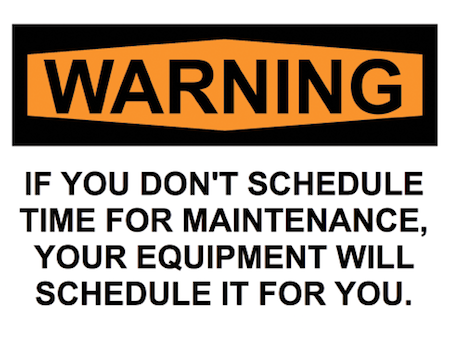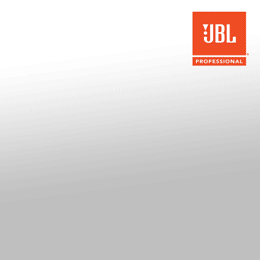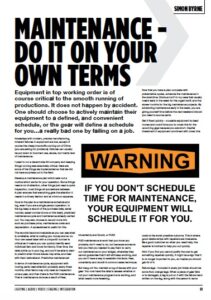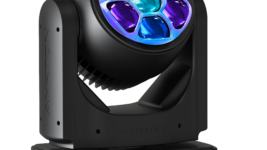Subscribe to CX E-News
Simon Byne
Maintenance – Do It On Your Own Terms
Equipment in top working order is of course critical to the smooth running of productions. It does not happen by accident. One should choose to actively maintain their equipment to a defined, and convenient schedule, or the gear will define a schedule for you… a really bad one by failing on a job.
Nowadays with modern, precise manufacturing, inherent failures in equipment are low, except of course the cheap knockoffs coming out of China (you are asking for problems). Failures can usually be put down to incorrect use, abuse, but mainly lack of maintenance.
I used to run a decent size AV company and keeping things running was absolutely critical. Here are some of the things we implemented so that we did not have surprises out in the field: Develop a maintenance plan which sets out a routine which works for your operation. Some things need a lot of attention, other things just need a quick inspection, most things sit somewhere between.
A plan ensures that everything gets the attention it needs in a timely fashion and at minimum expense. Core to the plan is a maintenance schedule and log, even if you are a single person operation. In the log keep a record of the purchase date, serial number, asset number (more on this later), predicted maintenance cycle and maintenance already carried out. You may also choose to record more info such as purchase price, maintenance costs and depreciation. A spreadsheet is useful for this.
The records become invaluable as you can see what is unreliable, what is costing you money and so on. Your own asset label with a unique ID number is critical as it means you can quickly identify each individual item and know its history. Over time, the data builds up in your log, and you’ll be able to start to predict when future issues may arise, and deal with them beforehand. Predictive maintenance! In terms of maintenance cycle, equipment with moving parts need attention probably every three months, other items may only need an inspection once a year, and then there is the FUD maintenance. That is maintenance done as a result of Fear,Uncertainty and Doubt, or FUD!
FUD maintenance is work that you know you probably don’t need to do, but because someone told you that you needed to pay them to carry out maintenance on your widget, otherwise they cannot guarantee that it will still keep working, and you don’t have a way to establish the facts. Fear, uncertainty and doubt! A common sales technique. But hang on! You maintain a log of issues with your gear. You now have the data to assess whether or not your maintenance programme is working, and what needs more tweaking.
Now that you have a plan complete with preventative cycles, schedule the maintenance in the downtime. Obvious huh? In my case that usually meant early in the week for the urgent stuff, and the slower months for the big maintenance projects. By scheduling maintenance early in the week, you are giving yourself time before the next weekend should you need to source parts. Get it fixed quickly – unusable equipment is dead money and could force you to cross hire for the upcoming gigs because you are short.
Capital investment in equipment combined with cross hire costs is the worst possible outcome. This is where good relationships with repairers are invaluable. Be a good customer so when you need help, the repairer is inclined to help you out quickly. Hint: if you find you cannot justify the cost to get something repaired quickly, it might be a sign that it is no longer important to you, so maybe you should get rid of it.
Failure tags – Included in every job folder should be some fluro orange tags. When a piece of gear fails or is damaged, a tag is put on it with the failure hand written on the tag, along with the person’s name who found the fault. Another fluro orange tag is put on its case. That way when the item comes back to the factory, everyone will quickly know that it needs attention.
Appliance Test and Tagging, AS3760. Ugh… Test and tagging is a critical part of your maintenance programme, mainly because it is law. It would cost me about $5,000 a year to do this and we rarely found items that failed. Why? Because our ongoing maintenance was so thorough that when we found a faulty cable or plug in the field, it would be orange fluro tagged and fixed within a week. Other than complying with the law, in my view, it was a useless and costly procedure.
Unfortunately, the standard is written badly, so no one really knows what is required to properly comply with the law. Until that is tested in court, no one will. And because it is largely a pointless exercise for the production industry, I can’t see it getting into court anytime soon. The standard states that the testing needs to be carried out by a “competent person”. What is that?
It would seem to mean that to be safe under the standard, most people need to do a course to demonstrate that they are “competent”. Seeing that it is law and you have to do it anyway, you might as well do it efficiently as possible, and take the opportunity to identify other maintenance issues at the same time.
In our case, we would do our entire inventory once a year, usually in January. Our Portable Appliance Testers would take about 20 seconds to do a test. That is downtime, so we would use that 20 seconds to give the widget a quick visual inspection and wipe down. If it was fine, it goes back into inventory, if not, it would be orange fluro tagged. It would take two people just over a week to do everything and that was with us being supremely efficient.
Handwritten electrical appliance tags are incredibly time wasteful. Printed tags are a must and because in most cases they need to be replaced every year, we did not worry about unique ID numbers on our tags. We did however take the opportunity to add our name and number so as well as complying with AS3760, they also were a form of owner identification.
Rigging maintenance – Rigging maintenance is critical for safety reasons. This is one area where properly trained people need to be actively ensuring that equipment cannot fall into a state where someone could get killed or injured. And that means the FUD maintenance needs to be carried out because if an accident were to occur due to equipment failure, you might have to prove in court that you complied with the manufacturers maintenance recommendations.
Shop air supply – Having a constant source of low pressure, dry air is really handy to quickly blow out dust and grunge from equipment, especially speakers and moving lights. A workshop air compressor works great as long it has an inline air filter and moisture trap.
Label consumables within equipment – for example, HID lamps in projectors are expensive so writing the installation date somewhere on it makes sense. I once proved to a manufacturer that their lamps were not living up to their claims using this method.
Firmware updates – are not a job for Fridays! Schedule your updates for a time where it does not matter if there are problems, because there often are. Never ever, should be done at a gig unless you have a plan to keep things running should the update fail.
Vocal Microphone Hygiene – you don’t want your singers picking up germs or viruses from the last performer do you? So we’d clean all our vocal microphone windscreens regularly and always disinfect them at the gig. A light spray of Glen 20 is all that is required and makeup remover will get rid of lipstick marks (makeup remover seems to clean most things. I’d hate to know what it is doing to people’s skin!).
The thing about maintenance is you can always spend more on it. You need to find the balance between cost and ensuring things are maintained adequately. By using your logs and schedules, you are able to objectively verify what is working and what needs more attention.
The goal is not to be reactive. You want to be in a place where you can confidently deliver your service without the worry of equipment failure. A well thought through maintenance program will achieve this whilst keeping costs contained.
Useful link – Brady Fluro Orange Tags
This article first appeared in the September 2018 edition of CX Magazine – in print and online. CX Magazine is Australia and New Zealand’s only publication dedicated to entertainment technology news and issues. Read all editions for free or search our archive www.cxnetwork.com.au
© CX Media
Subscribe
Published monthly since 1991, our famous AV industry magazine is free for download or pay for print. Subscribers also receive CX News, our free weekly email with the latest industry news and jobs.













